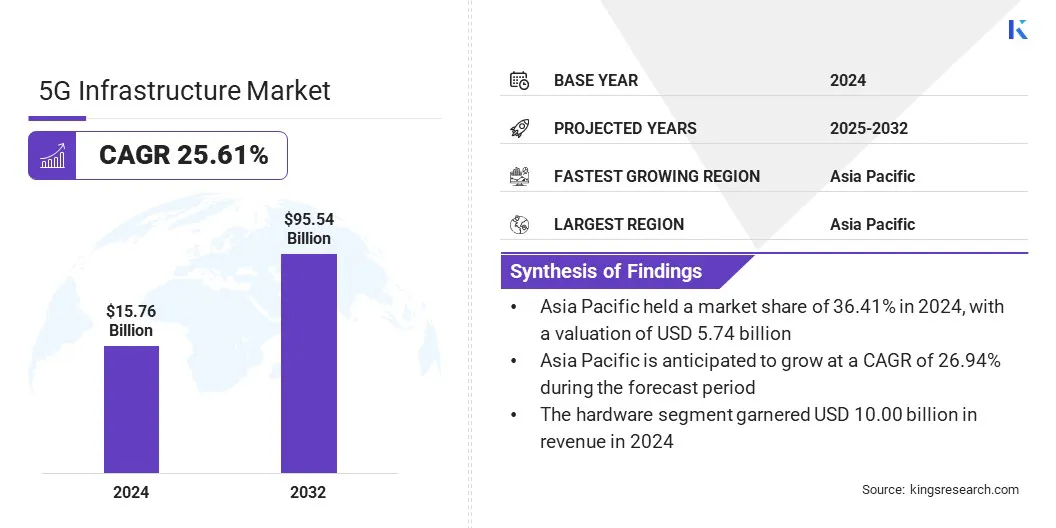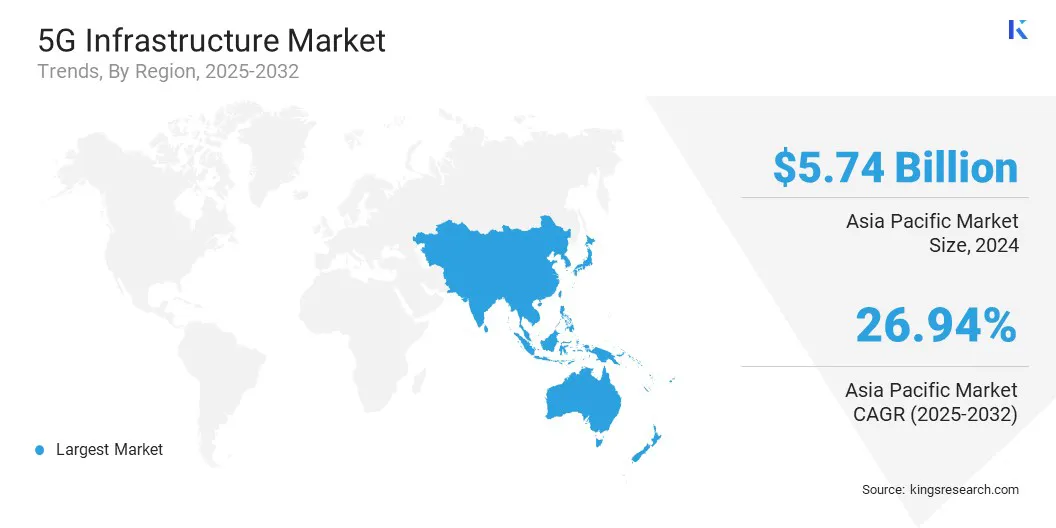Market Definition
The market comprises hardware, software, and services that support the deployment and management of fifth-generation wireless communication networks. These systems deliver ultra-fast data speeds, low latency, and high network capacity to enable next-generation connectivity.
The report covers segmentation by component, network architecture, spectrum band, end user, and region, offering insights into deployment trends, investment focus, and regional adoption. 5G infrastructure is used across sectors such as telecommunications, automotive, healthcare, manufacturing, and smart cities to facilitate digital transformation and connected ecosystems.
5G Infrastructure Market Overview
The global 5G infrastructure market size was valued at USD 15.76 billion in 2024 and is projected to grow from USD 19.36 billion in 2025 to USD 95.54 billion by 2032, exhibiting a CAGR of 25.61% during the forecast period.
Market growth is primarily driven by the rising demand for high-speed connectivity and the proliferation of Internet of Things (IoT) devices manufacturing, automotive, healthcare, and smart city infrastructure. The shift from 4G to advanced 5G networks supports ultra-low latency, enhanced bandwidth, and reliable real-time data transmission.
Key Highlights
- The 5G infrastructure industry was valued at USD 15.76 billion in 2024.
- The market is projected to grow at a CAGR of 25.61% from 2025 to 2032.
- Asia Pacific held a share of 36.41% in 2024, valued at USD 5.74 billion.
- The hardware segment garnered USD 10.00 billion in revenue in 2024.
- The standalone (SA) is expected to reach USD 51.21 billion by 2032.
- The high band (24-40GHz) segment is anticipated to witness the fastest CAGR of 29.59% over the forecast period.
- The telecom operators segment garnered USD 8.48 billion in revenue in 2024.
- Asia Pacific is anticipated to grow at a CAGR of 26.94% through the projection period.
Major companies operating in the 5G infrastructure market are Ericsson, Nokia, Huawei Technologies Co., Ltd., Samsung, ZTE Corporation, Qualcomm Technologies, Inc., Cisco Systems, Inc., Fujitsu, NEC Corporation, Intel Corporation, Juniper Networks, Inc., Dell Inc., Hewlett Packard Enterprise Development LP, Mavenir, and Rakuten Symphony.

The growing focus on digital transformation across telecommunications, automotive, healthcare, and manufacturing is fueling the adoption of 5G infrastructure. Additionally, continuous advancements in network virtualization, cloud infrastructure, and spectrum allocation by technology providers are significantly contributing to market growth.
- In August 2024, Nokia Corporation was selected by Claro Argentina to deploy a nationwide 5G network. The deployment includes Nokia’s AirScale portfolio, featuring base stations, baseband units, and Massive MIMO radios to improve network capacity and efficiency. Nokia will also deliver planning, deployment, and optimization services, making Claro Argentina the first operator in Latin America to implement its IPAA+ technology.
How is the rising demand for high-speed connectivity boosting the growth of the 5G infrastructure market?
Enterprises and consumers rely heavily on seamless communication networks to support data-intensive activities such as video streaming, remote collaboration, and immersive technologies.
Key industries, including telecommunications, automotive, healthcare, and manufacturing, are adopting 5G to enable real-time data exchange and improve operational efficiency. This increasing reliance on fast, low-latency networks is reinforced by expanding digital transformation initiatives and continuous investments in next-generation communication technologies, aiding market growth.
- In September 2025, GlobalLogic and Ericsson announced the deployment of a private 5G network at Hitachi Rail’s digital factory in Hagerstown, Maryland. The network provides high-speed and low-latency connectivity across the 307,000-square-foot facility, supporting advanced automation, safety systems, and digital manufacturing operations.
How is complex network integration affecting the expansion of the 5G infrastructure market?
Telecom operators must ensure seamless interoperability between new 5G systems and existing 4G, fiber, and legacy networks to maintain consistent connectivity and service quality. Integrating diverse hardware components, software platforms, and network management systems often leads to technical complexities and deployment delays.
These challenges are further compounded by compatibility issues, varying infrastructure standards, and the need for coordinated network optimization. To address these issues, operators are investing in virtualization, automation, and advanced network management tools to enable smooth migration and efficient operation of hybrid network environments.
How are advancements in network virtualization and edge computing influencing the 5G infrastructure market?
Advancements in network virtualization and edge computing are reshaping 5G infrastructure deployment and management to enhance network efficiency and responsiveness. Telecom operators are shifting from traditional hardware-based systems to virtualized architectures using software-defined networking (SDN) and network function virtualization (NFV), which enable greater scalability, flexibility, and cost optimization.
The integration of edge computing allows data to be processed closer to end users, reducing latency and improving real-time performance for applications such as autonomous vehicles and industrial automation. As investments in these technologies increase, network operators can deliver faster, more reliable, and intelligent 5G services to support emerging digital ecosystems.
- In October 2024, the European Commission approved an investment of USD 1,003.7 million (€865 million) under the Connecting Europe Facility (CEF) Digital Work Programme for 2024–2027. The funding aims to expand high-capacity connectivity networks, including 5G corridors and backbone infrastructure across the European Union. The initiative seeks to strengthen digital resilience, enhance cross-border communication, and support the rollout of advanced 5G services in key transport and industrial sectors.
5G Infrastructure Market Report Snapshot
|
Segmentation
|
Details
|
|
By Component
|
Hardware, Software, and Services
|
|
By Network Architecture
|
Standalone (SA), and Non-Standalone (NSA)
|
|
By Spectrum Band
|
Low Band (<1 GHz), Mid Band (1-6GHz), and High Band (24-40GHz)
|
|
By End User
|
Telecom Operators, Automotive, Healthcare, Manufacturing, Smart Cities, Energy & Utilities, and Others
|
|
By Region
|
North America: U.S., Canada, Mexico
|
|
Europe: France, UK, Spain, Germany, Italy, Russia, Rest of Europe
|
|
Asia-Pacific: China, Japan, India, Australia, ASEAN, South Korea, Rest of Asia-Pacific
|
|
Middle East & Africa: Turkey, U.A.E., Saudi Arabia, South Africa, Rest of Middle East & Africa
|
|
South America: Brazil, Argentina, Rest of South America
|
Market Segmentation
- By Component (Hardware, Software, and Services): The hardware segment earned USD 10.00 billion in 2024, primarily due to the large-scale deployment of base stations, antennas, and core network equipment supporting 5G rollout.
- By Network Architecture (Standalone (SA) and Non-Standalone (NSA)): The non-standalone (NSA) segment held a share of 58.64% in 2024, fueled by its faster deployment capability and reliance on existing 4G infrastructure for initial 5G implementation.
- By Spectrum Band (Low Band (<1 GHz), Mid Band (1-6GHz), and High Band (24-40GHz)): The mid band (1-6GHz) segment is projected to reach USD 52.90 billion by 2032, owing to its optimal balance between coverage and capacity that supports widespread commercial 5G deployment.
- By End User (Telecom Operators, Automotive, Healthcare, Manufacturing, Smart Cities, Energy & Utilities, and Others): The healthcare segment is anticipated to grow at a CAGR of 31.51% through the projection period, propelled by increasing adoption of 5G-enabled telemedicine, remote patient monitoring, and advanced healthcare automation solutions.
What is the market scenario in Asia Pacific and North America?
Based on region, the global 5G infrastructure market has been classified into North America, Europe, Asia Pacific, Middle East & Africa, and South America.

Asia Pacific 5G infrastructure market share stood at 36.41% in 2024, valued at USD 5.74 billion. This dominance is attributed to the region’s strong government initiatives supporting 5G rollout, expanding telecom investments, and growing focus on digital transformation across regions. Operators in the region are accelerating deployment through partnerships with technology providers to enhance network capacity, reliability, and coverage.
- In March 2025, the Government of India reported that 5G services had expanded to 99.6 percent of districts nationwide since their launch in October 2022. By February 2025, more than 469,000 base transceiver stations were operational, supporting nearly 250 million users on 5G networks. The update reflects continued progress of India’s telecommunications infrastructure and the large-scale deployment of advanced connectivity technologies.
Enterprises are increasingly integrating 5G connectivity into smart manufacturing, transportation, and urban development projects to improve productivity and service delivery. Rising demand for high-speed connectivity and the rapid expansion of smart city initiatives continue to support large-scale investments in 5G infrastructure across the region.
North America 5G infrastructure industry is set to grow at a CAGR of 25.62% over the forecast period. This growth is fostered by early 5G commercialization, strong investment from major telecom operators, and rising demand for high-capacity networks to support advanced digital services. Expanding adoption of connected technologies across industries such as automotive, healthcare, and manufacturing is accelerating infrastructure development across the region.
Additionally, enterprises are integrating 5G with cloud computing, edge processing, and Internet of Things (IoT) ecosystems to enhance operational agility and service delivery. Continuous advancements in network virtualization, combined with strategic collaborations between telecom and technology providers, are reinforcing North America’s position as a key market for 5G infrastructure innovation.
- In October 2024, the U.S. Department of Defense issued its Private 5G Deployment Strategy to guide the rollout of secure 5G networks at military installations. The strategy outlines criteria for deploying private networks when commercial solutions are inadequate and promotes the use of Open RAN technologies to enhance interoperability and security in defense communications.
Regulatory Frameworks
- In the U.S., the Federal Communications Commission (FCC) 5G FAST Plan regulates spectrum allocation and infrastructure deployment for fifth-generation wireless networks. It aims to accelerate 5G rollout by expanding access to high-, mid-, and low-band frequencies and streamlining approval processes for small cell installations, ensuring nationwide coverage and innovation in connectivity.
- In the EU, the European Electronic Communications Code (EECC) regulates the deployment and operation of 5G networks across member states. It promotes harmonized spectrum management, fair competition, and infrastructure sharing, supporting efficient 5G rollout and cross-border interoperability within the single digital market.
- In India, the Telecommunications Act, 2023 regulates spectrum assignment, telecom licensing, and 5G infrastructure deployment. It replaces legacy laws to provide a unified legal framework that supports rapid digital expansion, efficient spectrum utilization, and secure, high-speed communication networks.
Competitive Landscape
Companies in the 5G infrastructure industry are strengthening their competitive position through investments in advanced networking technologies, spectrum development, and large-scale infrastructure deployment. They are focusing on improving network performance, scalability, and energy efficiency to meet growing connectivity demands across industries such as telecommunications, automotive, healthcare, and manufacturing.
Market participants are expanding their portfolios with Open RAN solutions, virtualized network components, and edge computing capabilities to enhance flexibility and interoperability. Additionally, they are advancing their global reach and innovation capacity through strategic partnerships, mergers, and collaborations with telecom operators, cloud providers, and semiconductor manufacturers.
- In January 2025, Siemens AG expanded its private 5G infrastructure coverage to six European countries and Brazil to support broader industrial deployment. The enhanced system accommodates up to 24 radio units, each covering around 5,000 square meters, allowing efficient network scalability in manufacturing environments. Siemens also introduced the Scalance MUB852-1 compact 5G router for cabinet integration, designed to streamline connectivity within industrial automation systems.
Key Companies in 5G Infrastructure Market:
- Ericsson
- Nokia
- Huawei Technologies Co., Ltd.
- Samsung
- ZTE Corporation
- Qualcomm Technologies, Inc.
- Cisco Systems, Inc.
- Fujitsu
- NEC Corporation
- Intel Corporation
- Juniper Networks, Inc.
- Dell Inc.
- Hewlett Packard Enterprise Development LP
- Mavenir
- Rakuten Symphony
Recent Developments
- In July 2025, Ericsson and Liberty Latin America launched the first 5G standalone mobile network in Costa Rica and the Central American region. Covering over 1,400 sites, the network aims to improve capacity and reliability for approximately 3.7 million users across key sectors such as healthcare, agriculture, manufacturing, and tourism.


